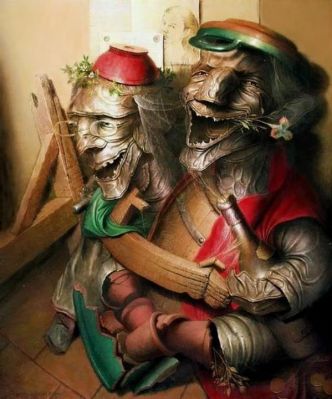
Continued from Part One…
- 1801 M. G. Lewis’s Tales of Wonder collects ballads with a supernatural
theme, adding several new compositions. - 1802 Walter Scott’s Minstrelsy of the Scottish Border provides a significant supplement to Percy’s Reliques.
- 1803 Robert Southey’s translation of Amadis de Gaul imports chivalric
romance into 19th-century Britain. - 1805 Walter Scott’s “Lay of the Last Minstrel” consolidates the Romantic image of the wizard in its depiction of Michael Scott.
- 1808 Goethe publishes the first part of his definitive allegorical version
of Faust. - 1811 Friedrich de la Motte Fouqué’s Undine and Ludwig Tieck’s “The
Elves” provide the paradigm examples of the German art fairy tale. - 1812 Jakob and Wilhelm Grimm issue the first volume of their Children’s and Household Tales, firmly establishing the notion of folktales as
tales told by adults to children. - 1813 Fouqué’s The Magic Ring revives the tradition of chivalric romance within the novel format. Percy Shelley’s “Queen Mab” establishes
an important precedent for the 19th-century English revival of fairy art and
literature. - 1814 The first volume of E. T. A. Hoffmann’s Tales in the Manner of
Callot and Adalbert von Chamisso’s Peter Schlemihl introduce a note of
sinister grotesquerie into the German art fairy tale. - 1818 Mary Shelley’s Frankenstein creates an important template for
tales of man-made monsters. - 1819 Washington Irving’s “Rip van Winkle” and “The Legend of Sleepy
Hollow” pioneer the invention of American “fakelore.” John Polidori’s
“The Vampyre” supernaturalizes Lord Byron. - 1820 John Keats’s “Lamia” and “La Belle Dame Sans Merci” reintroduce two carefully re-eroticized classic motifs into English Romantic fantasy. Shelley’s Prometheus Unbound provides a model of disguised literary Satanism.
- 1822 Charles Nodier’s Trilby imagines a goblin in love with a human
woman. - 1824 Walter Scott’s “Wandering Willie’s Tale” renders the substance of
a fantastic ballad into prose. William Austin’s “Peter Rugg—the Missing
Man” Americanizes a European folktale as an allegory of history. - 1828 Thomas Keightley’s Fairy Mythology provides a Bible for the English vogue; excerpts appear in the Athenaeum, assisting John Sterling’s experiments in fantasy fiction.
- 1831 Honoré de Balzac’s account of The Wild Ass’s Skin provides a paradigm example of modern moralistic fantasy. Nikolai Gogol’s Evenings on
a Farm near Dikanka give literary form to Russian folklore. - 1832–33 Benjamin Disraeli’s “Ixion in Heaven” exemplifies the use of
classical fantasy as political allegory. - 1833 James Dalton’s The Invisible Gentleman attempts to adapt humorous moralistic fantasy to the three-decker format.
- 1834 The diffusionist thesis of Keightley’s Tales and Popular Fictions
emphasizes the contribution of recycling and transfiguration to the heritage of modern fantasy. - 1835 Elias Lonnrott compiles the Kalevala, synthesizing a Finnish
“epic” from fragmentary folk songs. Hans Christian Andersen begins publishing his synthetic fairy tales. - 1836 Théophile Gautier’s “Clarimonde” breaks new ground in erotic
fantasy. Gogol’s “The Nose” reinvents absurdist satire. - 1837 Sara Coleridge’s Phantasmion provides a significant example of an
allegorical fairy romance with elements of heroic fantasy. Nathaniel
Hawthorne’s “Dr Heidegger’s Experiment” assists the foundation of an
American tradition of fantastic contes philosophiques. Andersen’s “The
Little Mermaid” warns young women of the dangers of standing on their
own two feet. - 1838 John Sterling’s The Onyx Ring attempts to found an English tradition of experimental contes philosophiques in novel form.
- 1839 Captain Marryat’s account of The Phantom Ship transfigures the
myth of the Flying Dutchman. - 1840 Edgar Allan Poe’s Tales of the Grotesque and Arabesque takes up
where John Sterling left off in demonstrating the breadth and versatility of
the fantasy spectrum. The first series of R. H. Barham’s Ingoldsby Legends
provides a crucial exemplar for English humorous fantasy. - 1842 Edward Bulwer-Lytton’s Zanoni provides a key exemplar of occult
fantasy and launches a thousand lifestyle fantasies. Poe’s “The Masque of
the Red Death” establishes a paradigm of decadent fantasy. Robert Browning’s “The Pied Piper of Hamelin” recycles a famous folktale in hectic
rhyme. - 1843 Charles Dickens’s A Christmas Carol creates the tradition of
moralistic Christmas fantasy. Richard Wagner’s “The Flying Dutchman”
begins his development of fantasy in musical form. - 1844 Dickens’s The Chimes attempts to strike a great blow for the poor
but exposes the limitations of moralistic fantasy. Nathaniel Hawthorne’s
account of “Rappaccini’s Daughter” aims at a softer target. - 1845 Andersen’s “The Ugly Duckling” gives an archetypal form to a
hopeful modern myth. Heinrich Hoffmann’s Struwwelpeter takes the tactics of parental moral terrorism to a new extreme. - 1846 Andersen’s “The Snow Queen” lays down a template for modern
Orphean fantasy. Edward Lear’s The Book of Nonsense takes up arms
against the tyranny of “common sense.” - 1848–49 Gustave Flaubert writes the first version of The Temptation of
Saint Anthony, working toward a modern conception of the Devil. Douglas
Jerrold’s A Man Made of Money demonstrates the literary potential of literalized puns. - 1850 Nathaniel Hawthorne’s “Ethan Brand” embarks upon a perverse
quest for the unpardonable sin.
-Stableford, Brian. The A to Z of Fantasy Literature. (Scarecrow Press, 1989)
